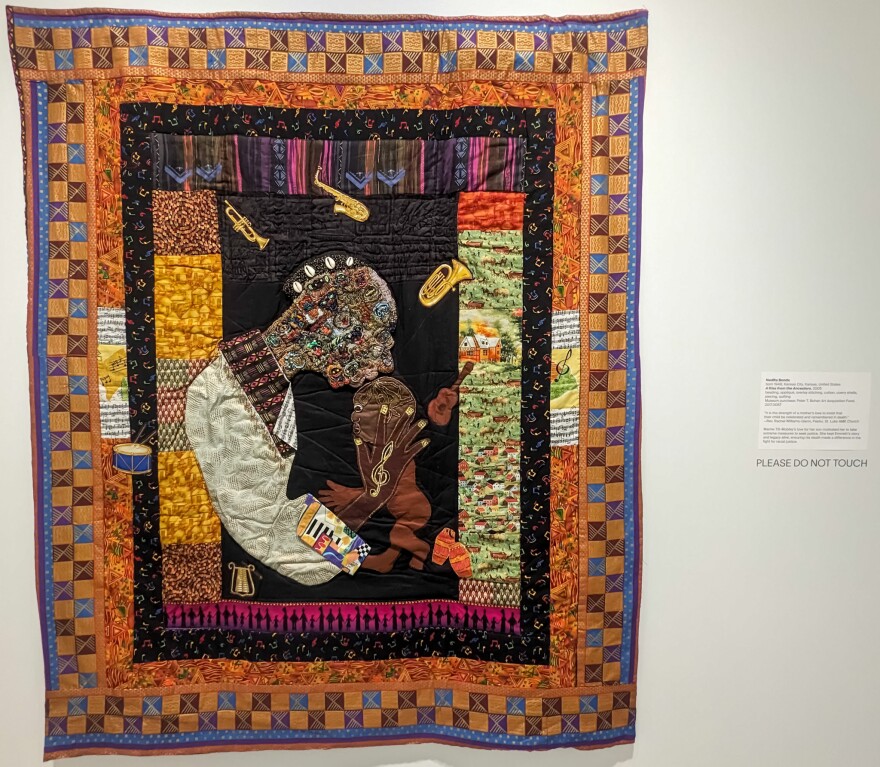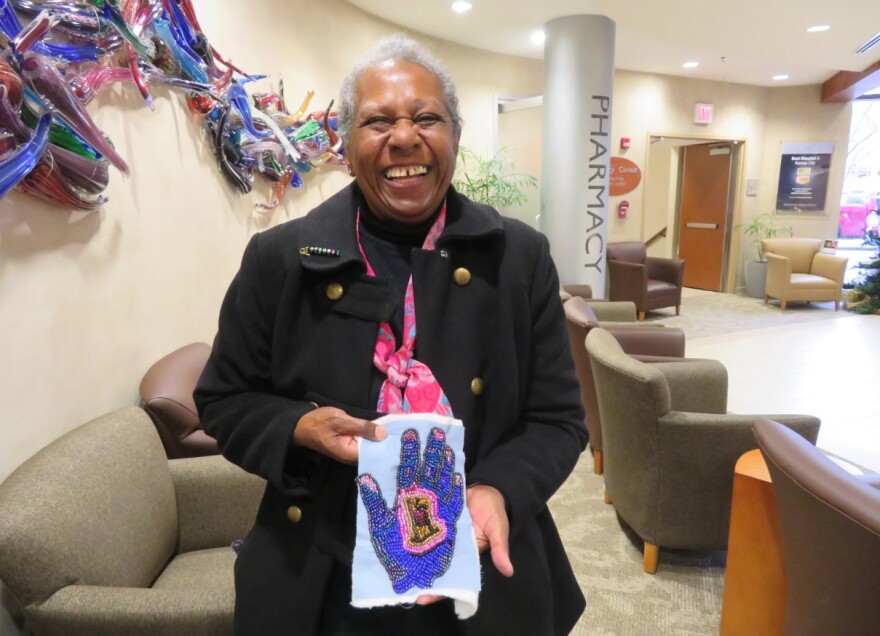Marla Jackson grew up in the shadow of Jim Crow segregation and Emmett Till’s 1955 murder. The 71-year-old says the story of Till, killed by vigilantes in Mississippi for allegedly whistling at a white woman, is still relevant.
“It's the same stories now,” says Jackson, a renowned quilter and textile artist. “Only thing changed is social media.”
“They're just shooting your babies right in front of us, and one calling for his mama,” she says, referring to George Floyd, who could be heard on video in 2020 calling for his mother while being asphyxiated by a Minneapolis police officer.
The high-profile killings loom large in a pair of exhibits now on view at the Spencer Museum of Art on the University of Kansas' Lawrence campus.
Jacksons’ artwork, and that of 13 more contemporary Black artists, is featured in the “One History, Two Versions” exhibit. The show plays companion to another exhibition that's traveled across the country since opening in the fall of 2022, “Emmett Till & Mamie Till-Mobley: Let the World See.” Both have been open since February.
The Till exhibit, in part, sets about humanizing the historical figure's boyhood existence, and conveying the depths of a mother's love for her son, even in senseless tragedy.
The complimentary exhibit draws on themes of Till’s story with a singular focus: drawing a direct line from Till’s murder to Trayvon Martin and beyond.
In Jackson's piece, titled “First Born,” a mother in African-themed clothing is seen holding her child upwards, towards the sun.
“It is such an honor and privilege,” says Jackson, who owns Marla Quilts Inc. in Lawrence and works with a network of quilters across North America.

Artist Nedra Bonds is a Kansas City quilter whose work is also included in “One History, Two Versions.”
Bonds, now 75, was 7 when Emmett Till was lynched. She says that moment is forever etched in her mind.
“I remember seeing that photograph of Emmett Till when they pulled him out of the water, and his mom had the open casket in Chicago,” says Bonds, who was born and raised in the historic Quindaro neighborhood of Kansas City, Kansas.
Bonds is best known for creating the “The Quindaro Quilt” in 1988. The 4-by-6-foot protest quilt depicts the neighborhood's history in abolitionism and the Underground Railroad.
Like Jackson, Bonds’ work in the KU exhibit depicts the bond between Black mother and child. Her “A Kiss from the Ancestor” piece uses beads as Bantu knots in the head of an elder, who is kissing a young family member on the forehead.

As a retired educator in early childhood education and art at Pembroke Hill School and Operation Breakthrough, Bonds sees the importance of passing down the stories from one generation to the next.
“It's important for young people to know, especially now, when governments don't want us to know the true history of Black people in this country,” she says. “So the way that I let people know is through quilts.”
'Art as a way to teach these histories'
Sydney Pursel, the Spencer Museum's curator for public practice, helped curate the exhibit in Lawrence. She says attacks in Kansas and Missouri on how Black history is taught is why some of the new artwork ties the past to the present.
“We have students from all walks of life that come through our building, but they might not go attend a Black Lives Matter protest," she says. "So it's a way that we can reach broader audiences and use art as a way to teach these histories."

Pursel didn’t come up with the intersecting exhibit themes alone. She notes contributions from partner organizations like the NAACP Lawrence, KS Branch and Justice for Wyandotte, a nonprofit dedicated to criminal justice reform.
She says the museum was intentional in making this project a true community collaboration and they had great discussions on how the new exhibit contributes to the traveling exhibit.
“The piece that you see initially and the piece that ends the show are about those two boys that have become martyrs for different generations,” Pursel says. “It really demonstrates the need for social justice work and activism to continue today.”
KU professor of communications Dave Tell served as a historical consultant for the design and content of the “Let the World See” exhibit. Tell, a scholar on the life of Emmett Till, also helped launch the Emmett Till Memory Project, an application that details important locations related to Till’s murder.
Tell says he dedicated some of his life’s work to keep Till’s memory alive partly because of the efforts to keep this story hidden where the crime took place.

“There has been a lot of resistance to telling Till's story,” Tell says. “If you start with the 1955 murder, you have to count 49 years and 11 months before the state of Mississippi dropped a single dollar to tell the story of Emmett Till.”
Helping curate a nationwide exhibit that does just that, he says, and bringing the exhibit to his home in Lawrence, is a surreal moment.
“What I get excited about is helping the family of Emmett Till as a historic consultant doing work that's important,” he says. “I'm just grateful that my job as a professor gives me a chance to do meaningful work that hopefully will change culture in the long run.”
“Emmett Till & Mamie Till-Mobley: Let the World See” runs through May 19 at the Spencer Museum of Art, 1301 Mississippi St., Lawrence, Kansas 66045. “One History, Two Versions” is on view through June 16. More information is at Spencerart.ku.edu.


